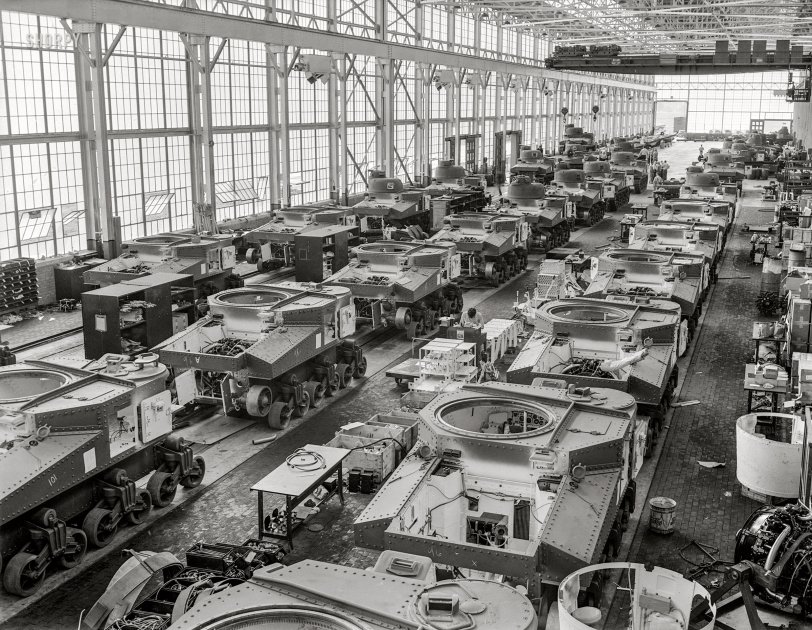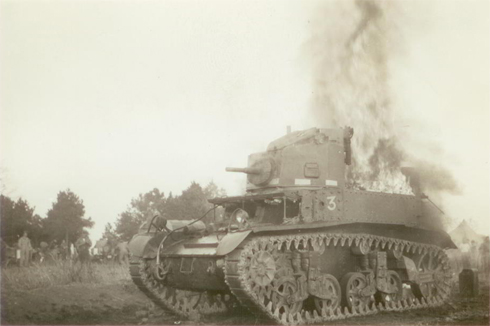


Framed or unframed, desk size to sofa size, printed by us in Arizona and Alabama since 2007. Explore now.
Shorpy is funded by you. Patreon contributors get an ad-free experience.
Learn more.

- Baldwin 62303
- Baldwin VO-1000
- Cold
- No expense spared
- Tough Guys
- Lost in Toyland
- And without gloves
- If I were a blindfolded time traveler
- Smoke Consumer Also Cooks
- Oh that stove!
- Possibly still there?
- What?!?
- $100 Reward
- Freeze Frame
- Texas Flyer wanted
- Just a Year Too Soon
- WWII -- Replacing men with women at the railroad crossing.
- Yes, Icing
- You kids drive me nuts!
- NOT An Easy Job
- I wonder
- Just add window boxes
- Icing Platform?
- Indiana Harbor Belt abides
- Freezing haze
- Corrections (for those who care)
- C&NW at Nelson
- Fallen Flags
- A dangerous job made worse
- Water Stop
Print Emporium
Arsenal of Democracy: 1941

August 1941. Warren, Michigan. "Tank manufacture (Chrysler). These are partially completed M-3 tanks, 28-ton steel giants being turned out at the huge Chrysler tank arsenal near Detroit. The camera was directed toward the end of the three main assembly lines. Mass assembly methods developed in automobile manufacture are used. Note overhead cranes for heavy parts." Photo by Alfred Palmer for the Office for Emergency Management. View full size.
Amazing times
I continue to be amazed at how America mobilized for WWII, the massive output of war machines, airplanes and ships. And how the railroads managed to come back from very lean years with worn out equipment to handle all the traffic.
America truly came together.
I'll be 80 in two days and really all I can remember is my dad being on the road as a Frisco engineer and the huge number of trains running then.
More About The Plant
Interesting info here about the tank plant in the photo:
Book
When I was younger, I found, in a used book store, a small book about the effort by an automotive manufacturer to build tanks for WWII. I believe it was actually published by the manufacturer to document their work after the war. Don't remember whether it was GM, Ford or Chrysler. But, it was a fascinating read, with pictures of the assembly process, at least one of them much like this one.
Hits the Spot
Looks like a very thrifty operation indeed, at least if judged by the recycled Pepsi-Cola bucket sitting on the floor just ahead of the stand-mounted engine at lower right.
Previously on Shorpy --
Quite a few Alfred Palmer 4x5 Kodachromes featuring M-3 crews training at Fort Knox have appeared on Shorpy. Here are a few:
Photographer
Is the photographer really Russell Lee? Per https://www.loc.gov/resource/fsa.8b00695/, the photographer is Alfred T Palmer.
[It is indeed and the caption has been corrected. - Dave]
Yank In A Tank
Upon further review, the tank on fire in the photo below is actually the M3 Stuart Light Tank which is different than the M3 Lee tanks in the manufacturing photo.

Continental R-975
Based on the glimpse of the yet-to-be installed engine on the floor in the bottom right-hand corner, this would appear to be one of the many thousands of Wright developed R-975 C1 air-cooled radial engines manufactured under license by Continental for use as a powerplant for Allied tanks and other armored vehicles.
http://usautoindustryworldwartwo.com/images/Continental%20Engine/r975-aa...
This engine in its C4 variant went on to be the main engine for the Sherman.
Not that the R-975 isn't a great engine (it is!) but it's a bit of a disappointment for me as I was hoping to catch sight of the Chrysler A57 Multibank. The A57 was a 30-cylinder 1,253 cid engine (five Chrysler 250.6 cid L-head inline six cylinder engines arranged around a central shaft) that was developed in 1941 out of the necessity for a rear-mounted tank engine to be developed and produced in the shortest time possible.
... and here I am, hijacking my own post about the R-975
For sheer output to space ratio, the Radial Engine configuration can't be beat.
M-3 Medium Tank (Lee)
as opposed to the M-3 Light Tank (Stuart). The Confederate general names were applied by the British to distinguish the tanks, with the Grant M-3 being a modified version that suited the Brits more. They were used extensively in the North Africa campaign by the British, despite the tank being a stopgap measure until the M-4 Sherman could be developed. An unusual characteristic was the 75mm cannon in a fixed sponson on the right side because a turret capable of handling such a large gun hadn't yet been developed. The turret at the top held a rapid firing 37mm cannon.
As a little note, the tank pictured by Vonderbees is an M-3 Stuart light tank. The Stuart has four road wheels and no 75mm cannon and the Lee six road wheels.
























On Shorpy:
Today’s Top 5